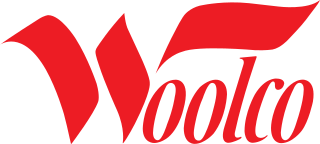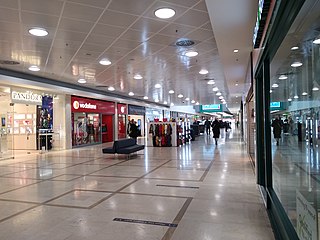Safeway Limited is a British groceries brand, and former chain of supermarkets and convenience shops. The British Safeway was founded in 1962 by the American Safeway Inc., before being sold to Argyll Foods in 1987. It was later listed on the London Stock Exchange. It was purchased by Morrisons in March 2004. Most of its 479 shops were rebranded as Morrisons, with others being sold. Safeway-branded shops disappeared from the United Kingdom on 24 November 2005.

Asda Stores Limited, trading as Asda and often styled as ASDA, is a British supermarket chain. Its headquarters are in Leeds, England. The company was incorporated as Associated Dairies and Farm Stores in 1949. It expanded into Southern England during the 1970s and 1980s, and acquired Allied Carpets, 61 large Gateway Supermarkets and other businesses, such as MFI Group. It sold these acquisitions during the 1990s to concentrate on the supermarkets. It was listed on the London Stock Exchange until 1999 when it was acquired by Walmart for £6.7 billion. Asda was the second-largest supermarket chain in the United Kingdom between 2003 and 2014 by market share, at which point it fell into third place.

Frank Winfield Woolworth was an American entrepreneur, the founder of F. W. Woolworth Company, and the operator of variety stores known as "Five-and-Dimes" which featured a selection of low-priced merchandise. He pioneered the now-common practices of buying merchandise directly from manufacturers and fixing the selling prices on items, rather than haggling. He was also the first to use self-service display cases, so that customers could examine what they wanted to buy without the help of a sales clerk.

The F. W. Woolworth Company was a retail company and one of the pioneers of the five-and-dime store. It was among the most successful American and international five-and-dime businesses, setting trends and creating the modern retail model that stores follow worldwide today.

Kingfisher plc is a British multinational retailing company headquartered in London, England.

Woolco was an American-based discount retail chain. It was founded in 1962 in Columbus, Ohio, by the F. W. Woolworth Company. It was a full-line discount department store unlike the five-and-dime Woolworth stores which operated at the time. At its peak, Woolco had hundreds of stores in the US, as well as in Canada and the United Kingdom. While the American stores were closed in 1983, the chain remained active in Canada until it was sold in 1994 to rival Walmart, which was looking to enter the Canadian market. All of the former UK Woolco stores were sold by Kingfisher, which had bought the UK Woolworth business, to Gateway which subsequently sold them to Asda.

Woolworths Group Limited is an Australian multinational retail and finance company, primarily known for the operation of its retail chain Woolworths Supermarkets across Australia, Woolworths in New Zealand and its discount department store Big W. Headquartered in Bella Vista, Sydney, it is the largest company in Australia by revenue and number of employees, and the second-largest in New Zealand.
A discount store or discounter offers a retail format in which products are sold at prices that are in principle lower than an actual or supposed "full retail price". Discounters rely on bulk purchasing and efficient distribution to keep down costs.

Woolworths was a British high-street retail chain. At its height, it operated as Woolworths Group PLC, which included other companies such as the entertainment distributor Entertainment UK, and book and resource distributor Bertram Books.

B&Q Limited is a British multinational DIY and home improvement retailing company, with headquarters in Eastleigh, England. It is a wholly owned subsidiary of Kingfisher plc. It was founded in March 1969 by Richard Block and David Quayle.
Netto is a Danish discount supermarket operating in Denmark, Germany and Poland. Netto is owned by Salling Group.

Lotus's is a retail chain in Thailand founded and operated by Charoen Pokphand (CP) Group, with operations in Malaysia following the acquisition of Tesco Malaysia in 2020.

A big-box store is a physically large retail establishment, usually part of a chain of stores. The term sometimes also refers, by extension, to the company that operates the store. The term "big-box" references the typical appearance of buildings occupied by such stores.

Comet Electricals Limited, trading as Comet, is an online electrical retail chain based in the United Kingdom. The company sells consumer electronics and white goods, along with related products and services. Its predecessor, under the same brand name, pioneered the concept of the out-of-town discount warehouse in the United Kingdom.

Entertainment UK Limited (EUK) was a retail supply and distribution company and a wholly owned subsidiary of Woolworths Group. The company, and Woolworths plc, entered administration with Deloitte on 26 November 2008. EUK claimed to have had a turnover in excess of £1.4 billion per annum, and over 160,000 lines of products.

Broadway Shopping Centre is the principal covered shopping centre in the town centre of Bexleyheath and is the largest single covered shopping facility in the London Borough of Bexley.
Superdrug Stores plc is a health and beauty retailer in the United Kingdom, and the second largest behind Boots UK. The company is owned by A.S. Watson Ltd which is part of the A.S. Watson Group. It was acquired as part of the buyout of Kruidvat BV in October 2002. The A.S Watson Group is itself part of the Hong Kong conglomerate CK Hutchison Holdings.
Woolworths (Ireland) was a retail chain that operated on the island of Ireland. Woolworths had operated stores in the Republic of Ireland until 1984, while stores in Northern Ireland became fully part of F. W. Woolworth plc and these stores lasted until 2009 when the Woolworths Group fell into administration. The defunct brand then being owned by The Very Group.

Żabka Polska, better known as Żabka is a chain of convenience stores in Poland. There are at least 9,000 manned and unmanned stores across Poland, including at least 500 in Warsaw and over 340 in the Tricity area, as of April 2024. Some Żabka stores are located in the Czech Republic and owned by the Czech branch of the UK retail giant Tesco plc. The retail turnover was about €650 million in 2010. As of 2022, Żabka had more than 15.5 million customers.














